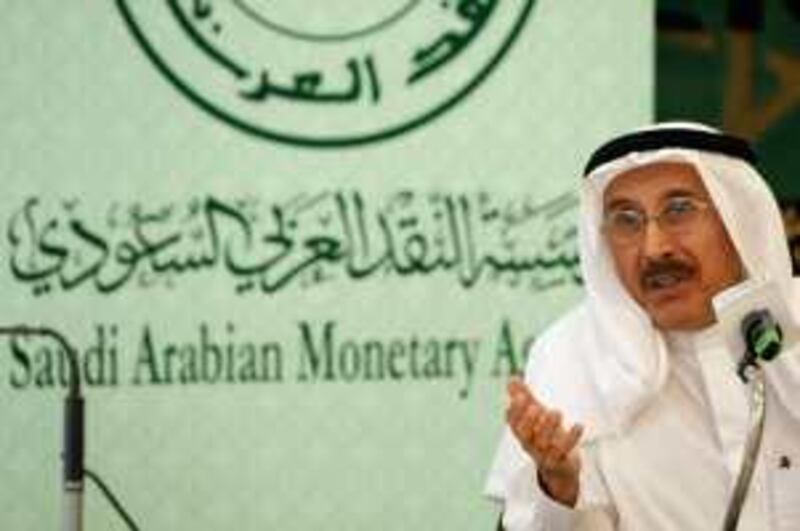The appointment of Mohammed al Jasser as the new Saudi Arabian Monetary Authority (SAMA) governor in the sweeping government changes undertaken by King Abdullah took some financial observers by surprise, but the changing of the old guard does not signify fundamental changes in policies. The departing governor, Hamad al Sayyari, who took over as acting governor in 1983 and was confirmed in the post in 1985, was the longest-serving central bank governor in the world on his retirement, a record that the US Federal Reserve's "guru", Alan Greenspan, could not match. Under Mr al Sayyari's stewardship, SAMA evolved into a respected global player with its prudent regulatory policies, which are now keenly examined by other Gulf central banks in these turbulent financial times. The early 1980s saw the completion of the "Saudisation" phase of wholly foreign-owned bank branches operating in the kingdom. It was a bold gamble that paid off handsomely for the Saudi banking sector, bringing long-term benefits to both Saudi and foreign partners. It also brought technical expertise, the grooming of future generations of Saudi bankers and the adoption of modern banking practices, albeit at a steep price. In the long run, the human "technology transfer" has made its mark as demonstrated by the fact that most senior banking positions are now held by Saudis, and some institutions felt confident enough to convert into full Saudi institutions and allow foreign partners to divest completely after Citibank's exit from Samba, the Saudi-American Bank. Some in the Gulf sneered at the experiment of Saudi-foreign partnerships and opted to go it alone. They are now regretting the missed opportunity. The second phase of SAMA's stewardship of the Saudi financial system was during the mid to late 1980s, when the banking system emerged relatively unscathed during a period of declining oil prices, government budget deficits, economic slowdown, corporate bankruptcies and loan defaults - something that is being mirrored in today's financial crisis. SAMA ensured that the banking system was protected from abuse and used the purchase-and-assumption method to merge banks and provide liquidity support to others. Having a central bank that has managed earlier crises and, above all, knows what to do in the current crisis, is a tribute to the supervisory lessons learned by SAMA's governors and their deputies over the years. The organisation also had to cope with the new rules of globalisation, which reintroduced foreign banks to Saudi Arabia following the nation's accession to the World Trade Organisation in Dec 2005. Once again, SAMA adapted to the new regime of supervising foreign banks to ensure that the kingdom did not suffer the fate of lax and diffused oversight over international banking entities, as happened with the debacle of the Bank of Credit and Commerce International (BCCI), when central bank regulators pointed accusing fingers at each other. To ensure that Saudi banks were solvent, SAMA has insisted on capitalisation ratios higher than those set by international standards. Saudi banks are among the most highly capitalised, averaging between 15 per cent and 18 per cent for Tier 1 capital - sneered at before the current financial crises by highly leveraged and undercapitalised institutions, but something for which there is much envy now. In the past decade, SAMA oversaw the expansion of the insurance sector and the formal evolution of the Saudi Stock Exchange into an autonomous capital market authority. Today, the Saudi market is the largest in the Arab world and SAMA has resisted direct intervention to support the market in times of falling prices, unlike other GCC initiatives. SAMA has argued that self-correction and long-term fundamentals are more important for a sound market regime. Looking ahead, what will the new SAMA governor face? Dr al Jasser is a professional economist by training. He has been the vice governor of SAMA since 1995 and has executive experience in multinational financial institutions such as the World Bank and the IMF. He will, by instinct, follow the same "steady as you go" policies of the outgoing governor. In the long term, SAMA will be challenged by issues such as more invigorated supervision and regulation of cross-border Saudi institutions and the foreign entities operating in the kingdom. The on-off issue of a unified GCC central bank and exchange-rate parity with the US dollar will not go away. SAMA will probably play a more active regulatory role in renewed interest in Islamic finance supervision and the deepening and development of the Saudi capital market through the issuance of corporate sukuks, or bonds. SAMA will continue to trust in its basic instinct for conservatism and continuity in times of uncertainty and doubts about the health of the global financial system. The old guard has changed at SAMA, but the baton of continuity and prudent supervision has been passed on to a safe pair of hands, and thanks is owed to Mr al Sayyari. Dr Mohamed A Ramady, is a former banker and a visiting associate professor in the finance and economics department at King Fahd University of Petroleum and Minerals in Dhahran, Saudi Arabia
Changing of the old guard at SAMA, but policies to stay same
The appointment of Mohammed al Jasser does not signify fundamental changes in policies.

More from the national




